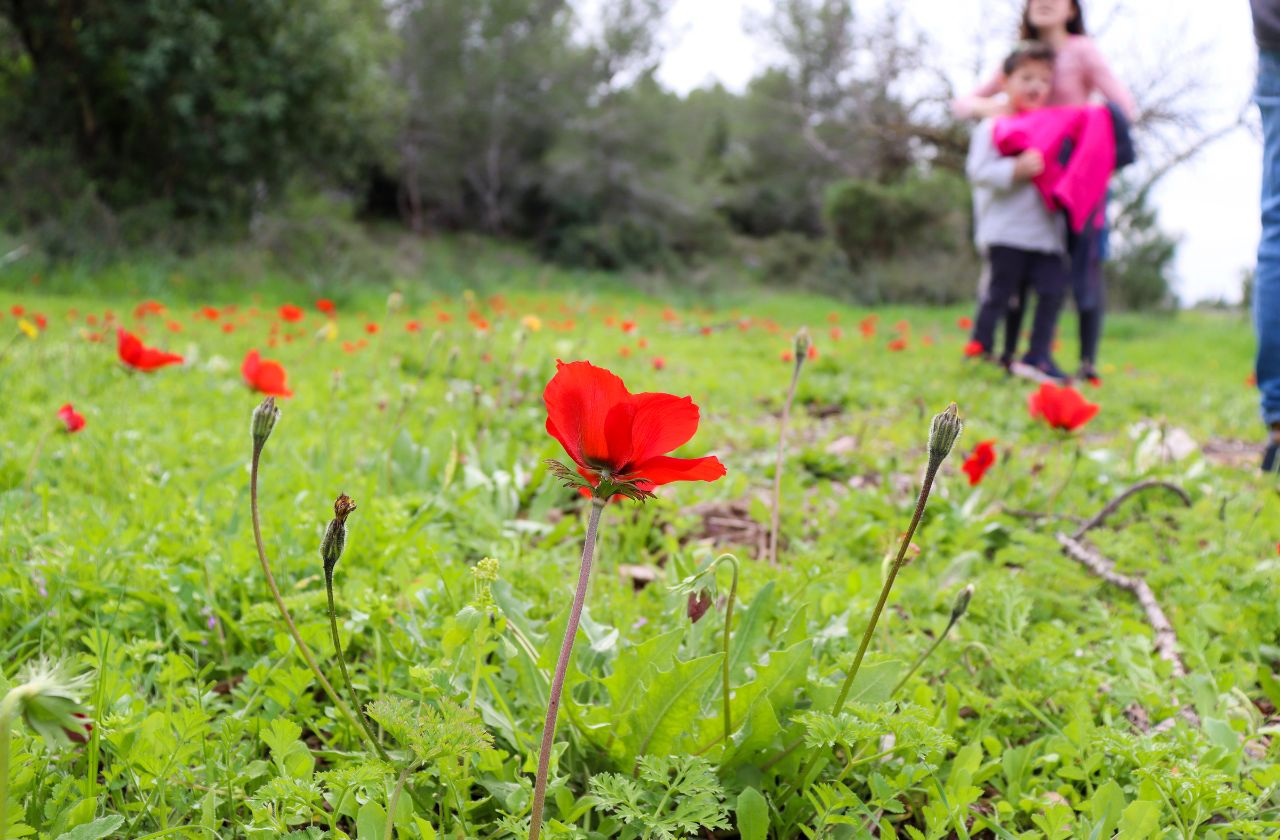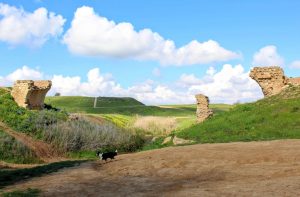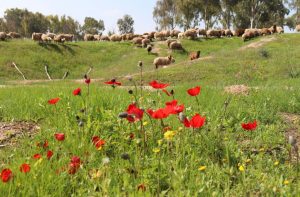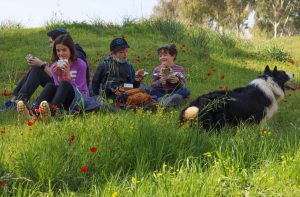February Travel Guide: Wildflowers
Written by Susannah Schild
Winter in Israel doesn’t bear much resemblance to the cold and snowy season in other parts of the world. In Israel, the land doesn’t exactly go into a winter slumber or turn brown and dry; rather, it comes to life, in a burst of lush, green beauty. This season means one thing to nature loving locals: wildflowers.
Travelers who are savvy enough to tap into the local obsession will find that it’s a simple matter to find a patch of wildflowers on a hiking trail in Israel. Pink cyclamen grow in abundance on forest trails, along with narcissus flowers, irises, and purple mandrakes. But there is one place that is uniquely beautiful when it comes to winter flower peeping: the Besor Region of Southern Israel. In February time, the scenery in this part of the country changes from monotone flatland into a sea of splashy, red color.
Here, a yearly festival takes place: Darom Adom, or Red South. It is thus named because of the plentiful, crimson anemone flowers which appear on the scene each year, transforming the local landscape into carpets of red. There are many spots in the south to hike or just stop and see these flowers.

Pura Nature Reserve
 The Pura Nature Reserve is one of the best spots to see red anemones in February. A stream flows through this National Park, attracting birds and wildlife. The area is full of historical remnants that add another dimension to the flower filled scenery. A picturesque Ottoman era bridge and an ancient tel (hill) give evidence to the rich past of the Pura Nature Reserve.
The Pura Nature Reserve is one of the best spots to see red anemones in February. A stream flows through this National Park, attracting birds and wildlife. The area is full of historical remnants that add another dimension to the flower filled scenery. A picturesque Ottoman era bridge and an ancient tel (hill) give evidence to the rich past of the Pura Nature Reserve.
Of course, there are the anemone flowers as well. Pura Nature Reserve is an easy place to spot these red beauties. Visitors to the nature reserve can follow the trails out for several kilometers, to scout out anemones all around the park. Those who would rather not walk very far can see red flowers too; at the entrance to the park, anemones grow abundantly on the grassy, green hills, granting easy access to all.
Those who venture forth will be rewarded with more variety. Throughout the park, patches of purple and yellow flowers join their red companions in the field.
Nahal HaBesor
 The trail along Nahal HaBesor is flat and easy to walk. A seven kilometer loop trail at this nature reserve follows a small stream, filled with plants and bird life.
The trail along Nahal HaBesor is flat and easy to walk. A seven kilometer loop trail at this nature reserve follows a small stream, filled with plants and bird life.
Hiking along the trail in February, travelers will feel like they’ve been transported into a cheery, spring-like Garden of Eden. At Nahal HaBesor, there are carpets of red anemones in mid to late February. Earlier in the month, visitors to the trail will find a multicolored array of wildflowers, from deep yellows to rosy pinks to pale whites.
The path at Nahal HaBesor is easy to follow. After crossing a bridge to reach the other side of the river, the trail leads up through the flatland along the stream, then crosses around a reservoir on the other side. This hike is a great choice for an easy, long walk in wildflower country.
Shokda Forest
 Not far from Nahal HaBesor lies a different kind of landscape for flower peeping: Shokda Forest. In Shokda Forest, eucalyptus trees provide shade along the trail.
Not far from Nahal HaBesor lies a different kind of landscape for flower peeping: Shokda Forest. In Shokda Forest, eucalyptus trees provide shade along the trail.
Visitors who come to Shokda will find a more varied landscape than in some other places in the south. At Shokda, sheep graze alongside patches of crimson flowers. A dark forest provides a welcome escape from the warm winter sun.
A circular, five kilometer trail leads through the park, offering enough variety to create a more interesting red flower peeping experience for hikers. On the sunny parts of the trail, red anemones are plentiful and beautiful just as those in other parts of the region.
Haruvit Forest

Red anemone season isn’t just for hikers. In Haruvit Forest a handicapped accessible trail leads through beautiful red flower fields and forests.
With a playground and picnic tables at the beginning of the trail, this hike is great for families with small children. While there are no long trails at Haruvit, the park is located further north than some of the other anemone peeping spots, making it accessible in more ways than one.
Fact File
Go: Pura Nature Reserve, Nahal HaBesor, Shokda Forest, Haruvit Forest
Who: All of these trails are well suited for people of all ages and skill levels. Those who are not strong hikers can view anemone fields right near the main parking areas. Families with children will enjoy short hikes in any of these areas, particularly Shokda Forest. Experienced hikers can hike out for many kilometers, enjoying the varied scenery, especially at Pura and Nahal HaBesor. The trail at Haruvit Forest is handicapped accessible, and it is well suited for those who need a flat place to walk.
What to Bring: A small hiking backpack, water, food, sunscreen, and a hat.
Where: These trails are all located in the northern part of Southern Israel, about an hour from Jerusalem.
How Long: At Pura Nature Reserve and Nahal HaBesor, the full trails are about seven kilometers long. The circular trail at Shokda is five kilometers long. The trail at Haruvit Forest is less than a kilometer.
Cost: All of these hikes are located at free entry sites.
How to Get There: Drive to Pura Nature Reserve, Nahal HaBesor, Shokda Forest, or Haruvit Forest using the directions in the posts (click on the links).
When: The best time to visit these trails is in the month of February. At any other time of year, there is not much to see on these hiking trails.
Planning: There are no facilities at Pura, Nahal HaBesor, or Shokda Forest. At Haruvit Forest there are bathrooms and picnic tables in the park.
All Photo Credits: Susannah Schild
Related Articles
Related
The Trip of A Lifetime: Panama City
I have a great brother. When I told him I was planning to retire he gave me the surprise of a lifetime. He let me use his miles to go on a trip of my dreams. I had to choose between Madrid, Barcelona, Lisbon, London or Panama. I chose Panama, why? It is close to New...
Where in the World Is…Bhutan?
Like stepping into a time machine, the first glance around the landscapes of Bhutan can stir the senses in a dizzying array of ancient charm, history and awe. Nestled in the foothills of the Himalayan mountains exists the mysterious “Thunder Dragon Kingdom”. On the...
December Travel Guide: Eilat
At the edge of the Negev Desert, a resort city full of beautiful beaches, bustling nightlife, and Las Vegas-style hotels awaits. Eilat – Israel’s southernmost city – is everyone’s favorite winter destination. But this town is more than just a fun place to vacation...
